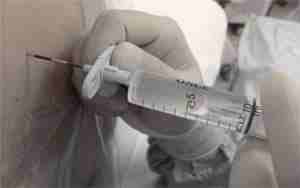Saline or Air?
Loss of resistance can be performed using saline or air. The techniques vary subtly.
In the case of saline, gentle but constant pressure is applied to the syringe whilst both syringe and needle are advanced slowly and continuously in unison. Loss of resistance is what is sought. If air is used, the technique is one of intermittent needle advancement, with compression or 'ballottement' of the syringe after each advancement. In effect, a change in impedance is what is being sought.
Using air carries the risk of certain side effects, including neurologial symptoms secondary to pneumocephalus (reports include severe headache, nausea and vomiting, seizures and hemiparesis) and patchy analgesia (secondary to air pockets in the epidural space). There are also arguments about the sterility of room air. However, it is argued that using air makes dural puncture easier to detect.
Using saline may mimic or mask inadvertent dural puncture. However, it may be positively protective: it has been shown to decrease the rate of venous cannulation.
Saline appears to be more popular, but there is no consensus. What is certain is that both techniques are successfully and routinely used by many practitioners. Until one is proven to be superior, what is important is to learn one technique and master it.
